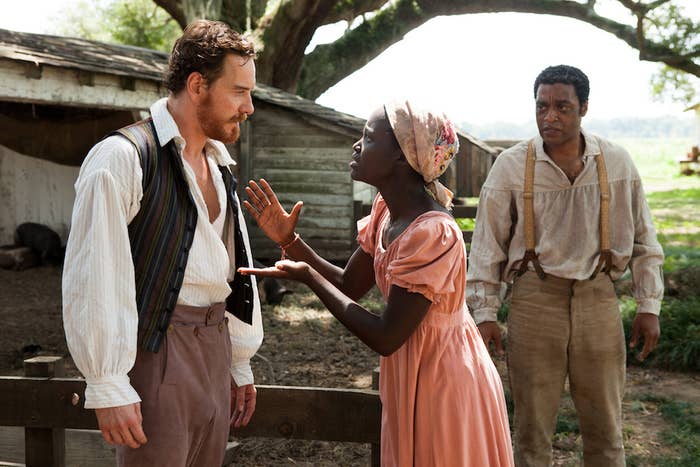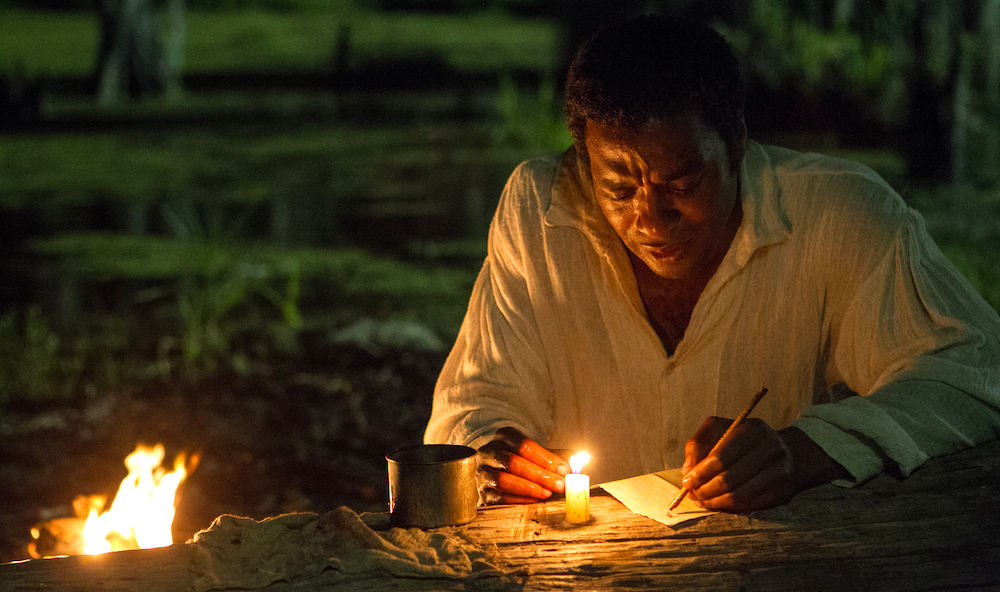
It's just acting.
It's a common refrain among audiences (and some actors), a reminder that whatever we're seeing on screen, however difficult or amazing, isn't technically real.
But sometimes there are movies, or scenes, or even just fleeting moments, that we cannot shake, that sear themselves so fully to our synapses that not only do we know we will never forget them, but we wonder how on Earth the people who made them possible could have survived them. Think of the gas chamber sequence in Schindler's List, or the rape scene in The Accused.
Or the whipping scene in 12 Years a Slave, which premiered to wide acclaim at the Telluride and Toronto Film Festivals earlier this year, and opens in Los Angeles and New York this weekend.
In truth, there are several sequences in the film — based on the true story of Solomon Northup, a free black man illegally kidnapped and sold into slavery in 1841 — that are memorably difficult to watch. But the scene likely to remain parked in many moviegoers' minds well after leaving the theater is the climactic, nearly unbroken shot in which plantation owner Edwin Epps (Michael Fassbender) forces Northup (Chiwetel Ejiofor) to whip his friend and fellow slave Patsey (Lupita Nyong'o) for leaving the plantation to find soap.
At the Toronto Film Festival, screenwriter John Ridley (Red Tails) told me that the most difficult thing about the scene for him as a writer was not allowing Solomon to prevent Patsey from coming to any real harm. "You wanted Solomon to do more, but you realize the circumstances, he couldn't," he said. "You don't want that to go down the way it went down." Ridley added that once he committed to capturing the scene as Northup described in his memoir, the intellectual exercise of giving the scene its necessary cinematic structure allowed him to remain at a remove. But after seeing the sequence once in a private screening room, he says he could not bring himself to watch it again at the film's gala premiere at Toronto.
"I can't imagine what it was like being an actor in that moment and having to channel those things," he said. "That's a moment where I was very glad to just be the writer."
So how did the actors get through being in the scene?

Logistically, it was a matter of some old-school camera trickery — the whip never came close to Nyong'o's back, but it looked like it did thanks to the camera angles director Steve McQueen chose for the scene, and Nyong'o moving her body as if she was being whipped. And when the camera swings around to capture the ruin inflicted upon Patsey's back, the effect is a combination of practical make-up and CGI.
Emotionally, however, it was far less cut-and-dried. For Nyong'o — acting in her very first feature film — it was about finding the right psychological touchstone to help her arrive at a place where she could do her job.
"Patsey in the book, in the script, is described as being effortlessly sensual," she told me. "I thought about that for a long time. What does that mean, to be effortlessly sensual? Then I found this quote from James Baldwin's book A Fire Next Time. He says, 'To be sensual, I think, is to [respect and] rejoice in the force of life, of life itself, and to be present in everything that one does, from the effort of loving to the breaking of bread.' That was Patsey. She was present. So that was a guiding principle for that scene. I couldn't possibly prepare for it an any other way than just to be there."
And being there was more than enough to handle. "The reality of the day was that I was stripped naked in front of lots of people," Nyong'o said. "It was impossible to make that a closed set. In fact, I didn't even ask for it to be a closed set, because at the end of the day, that was a privilege not granted to Patsey, you know? It really just took me there. It was devastating to experiencing that, and to be tied to a post and whipped. Of course, I couldn't possibly be really whipped. But just hearing the crack of that thing behind me, and having to react with my body, and with each whip, get weaker and weaker…" She grew quiet, and sighed. "I mean, it was — I didn't practice it. It was just — it was an exercise of imagination and surrender."

Ejiofor had far more experience with on screen acting than his costar. Originally a British stage actor, one of his earliest film roles was in Steven Spielberg's Amistad, one of the very few feature films to deal directly with the experience of being a slave. He's since starred in films both stark and challenging — like his first starring role, 2002's Dirty Pretty Things — and playful and popcorn-y — like 2009's cornball disaster flick 2012.
But he says he was ultimately not quite prepared for what he would be undertaking when he signed on to the role of Solomon Northup. "I had the book, and the script, and Steve McQueen," he said. "And I'd watched Steve McQueen films before, you know. I had seen Hunger. I had seen Shame. So I kind of figured, OK, this is going to be an intense experience. But I had no idea what it would actually mean in its reality."
In fact, after shooting the whipping scene, as well as so many other scenes of harrowing cruelty, Ejiofor had to deliberately withdraw from the world to recover. "After we finished shooting it, I took two months to decompress in Brooklyn, where I don't know that many people," he said. "But I did live there when I was in my mid-20s. So I know enough people that if I need to go out and have contact, I can. But I'm not surrounded by people, and nobody's going to think I'm crazy. 'He's disappeared!' or 'He's babbling at dinner about man's inhumanity to man!'"
At this point, Ejiofor laughed, loudly and deeply, and whatever concern I had felt about this man's psyche dissolved. He was going to be fine. "But it took me a while," he was quick to note. "We had to go to all of those places and to feel all of those things. What you're holding onto is the fact that you want to tell this story, so you're prepared to go there in the hope that two months later you come out the other side and you're all OK."
